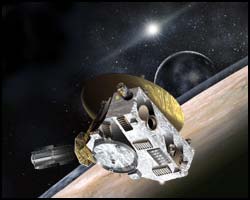Journey Begins for NASA’s New Horizons Probe

New Horizons: Pluto/Charon <br>Artist’s concept of the New Horizons spacecraft during its planned encounter with Pluto and its moon, Charon. The craft’s miniature cameras, radio science experiment, ultraviolet and infrared spectrometers and space plasma experiments would characterize the global geology and geomorphology of Pluto and Charon, map their surface compositions and temperatures, and examine Pluto’s atmosphere in detail. The spacecraft’s most prominent design feature is a nearly 7-foot (2.1-meter) dish antenna, through which it would communicate with Earth from as far as 4.7 billion miles (7.5 billion kilometers) away. Credit: Johns Hopkins University Applied Physics Laboratory/Southwest Research Institute (JHUAPL/SwRI)
APL-Built Pluto Mission Spacecraft Shipped to NASA Goddard for Pre-launch Tests
The first spacecraft designed to study Pluto, the solar system’s farthest planet, took the first steps on a long journey today when it was shipped from the Johns Hopkins University Applied Physics Laboratory (APL) in Laurel, Md. — where it was designed and built — to NASA’s Goddard Space Flight Center in Greenbelt, Md., for its next round of pre-launch tests.
Proposed for launch in January 2006, the New Horizons spacecraft spent the past week in an APL vibration test lab, where engineers checked the structural integrity of the piano-sized probe aboard a large shake table. The table simulated the energetic ride New Horizons would encounter during liftoff aboard an Atlas V – one of the largest launch vehicles NASA uses.
“Our testing program is off to a good start,” says Glen Fountain, New Horizons project manager at APL. “We’ve shown that New Horizons is structurally ready for the ride on the launch vehicle, and now we’ll test it in the full range of conditions it would face on the voyage to Pluto, Pluto’s moon, Charon, and beyond.”
Over the next three months at Goddard the mission team will check New Horizons’ balance and alignment in a series of spin tests; put it before wall-sized speakers that simulate the noise-induced vibrations of launch; and seal it in a four-story thermal-vacuum chamber that duplicates the extreme hot, cold and airless conditions of space. This fall the team plans to transport New Horizons to Kennedy Space Center, Fla., for final launch preparations.
“The scientific community has put high priority on exploring the frontier that is the Pluto system and the Kuiper Belt beyond,” says Dr. Alan Stern, New Horizons principal investigator, from the Southwest Research Institute in Boulder, Colo. “With the move of New Horizons from APL to NASA’s Goddard Space Flight Center, we are closer to achieving this historic exploration.”
Pending completion of environmental reviews and launch approvals, the spacecraft would launch from Cape Canaveral Air Force Station, Fla., during a 35-day window that opens Jan. 11, 2006. The boost from the Atlas V and a STAR-48B kick motor would send the relatively light New Horizons on the fastest spacecraft trip ever to the outer solar system, reaching the moon’s orbit distance less than 9 hours after launch and zooming through the Jupiter system just 13 months later.
Jupiter’s gravity assist would put the 1,000-pound craft on course for a five-month-long flyby reconnaissance of Pluto-Charon in summer 2015, when the “double planet” would be about 3.1 billion miles from Earth. As part of an extended mission, the spacecraft could also head farther into the Kuiper Belt to examine one or two of the ancient, icy mini-worlds in the vast region at least a billion miles beyond Neptune’s orbit.
New Horizons is the first mission in NASA’s New Frontiers program of medium-class, high-priority solar system exploration projects, and the 62nd spacecraft built at APL. As principal investigator, Stern leads a mission team that includes APL, Ball Aerospace Corporation, the Boeing Company, NASA Goddard Space Flight Center, the Jet Propulsion Laboratory, Stanford University, KinetX, Inc., Lockheed Martin Corporation, University of Colorado, the U.S. Department of Energy and a number of other firms, NASA centers and university partners.
Media Contact
More Information:
http://pluto.jhuapl.eduAll latest news from the category: Physics and Astronomy
This area deals with the fundamental laws and building blocks of nature and how they interact, the properties and the behavior of matter, and research into space and time and their structures.
innovations-report provides in-depth reports and articles on subjects such as astrophysics, laser technologies, nuclear, quantum, particle and solid-state physics, nanotechnologies, planetary research and findings (Mars, Venus) and developments related to the Hubble Telescope.
Newest articles

How marine worms regenerate lost body parts
The return of cells to a stem cell-like state as the key to regeneration. Many living organisms are able to regenerate damaged or lost tissue, but why some are particularly…

Nano-scale molecular detective
New on-chip device uses exotic light rays in 2D material to detect molecules. Researchers have developed a highly sensitive detector for identifying molecules via their infrared vibrational “fingerprint”. Published in Nature…

Novel CAR T-cell therapy
… demonstrates efficacy and safety in preclinical models of HER2-positive solid tumors. The p95HER2 protein is found expressed in one third of HER2+ tumors, which represent 4% of all tumors….



